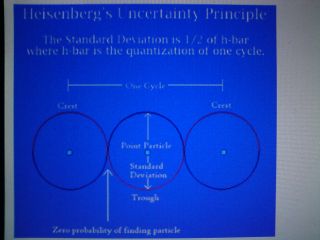
27th july 2013 THE UNCERTAINTY PRINCIPLE the uncertainty principle is the result of asking two different questions of the same thing at the same time it came to light when quantum theory was being formulated (1900-1926) the question "where is it?" wants to know the position of something whereas the question "what's it doing?" wants to know its motion it isn't unreasonable to say "john chucked the ball to mary" and feel satisfied that both questions are being answered in one sentence since it is known where john and mary are and the path of the ball could be seen however in the exact sciences people want to know precisely what's happening and where it's happening to know where the ball is at any given moment it means using a differential equation to work out where the ball is at every moment further, it means taking into account the resistance of the wind, the affect of gravity on the ball at different heights to the ground, the initial force the ball had... when particles are being investigated in the laboratory all of the factors are taken into account that's when it came to light... when the position of an electron is precisely defined it's not doing anything at the exact moment the measurement takes place, and as is the way of complementarity, when it's moving as a wave you know exactly what it's doing but don't know where it's doing it (see also conjugates)

|
sept 2009
because it is shrouded in mathematics ordinary people have settled into the frame of mind that the uncertainty principle means life is uncertain nothing could be further from the truth
the uncertainty principle used to be called the principle of indeterminacy let's give it its full name... the principle which doesn't allow us to determine exactly where something is and what and when something is at the same time because the answer would produce three absolutes asking the question where something is and what something is at the same time is an unrealistic question and it can only have an illogical or inconclusive answer
the theory being presented at this web site rests on the notion that there is only one absolute ( zero ) or there is one absolute for not being ( zero ) and another for being ( the straight line ) ( the equivalent of the absolute for being, this theory is proposing, is the straight line ) either way zero was first
the uncertainty principle infers that there can't be three absolutes at the same time so our curiosity about reality can only be ascertained or experienced one infinity at a time
the type of question that can be answered in absolute terms is... how many babies have been born since the world began or how many times has the tide occurred in eternity ? or how many planck time's has there been this undulation or who's the greatest kisser of us all ( the best kiss the writer has ever seen was in the film " the queen of outer space " )
we are starting to get a feel for when we are in time but haven't got the foggiest idea of where we are or what we are (consciousness) when traversing the straight line we'll know exactly what we are and where we are but wont have a clue when we are
as time goes by it will gradually come to be understood how love/life has taken these bits of reality and are using them to give us the feeling of permanently being thrilled to bits
|
the universe and all things in it are made up of particles all particles have the characteristic of moving in the shape of a wave when the particles clump together into objects that can be recognised, a button or a planet, the object still retains a wavy motion but the wave is too small to see or measure
the words in the picture above are... Heisenberg's Uncertainty Principle The Standard Deviation is 1/2 of h-bar where h bar is the quantization of one cycle. One Cycle Crest Crest Point Particle Standard Deviation Trough Zero probability of finding particle
